The main contractor on Europeʼs largest energy performance project has provided a solution. Such is its confidence in the punching power of efficient new technologies like LED light bulbs it is guaranteeing the energy savings — and promising to pay the difference should they not be achieved.
On the outskirts of Copenhagen, Hvidovre Hospital can be seen in a whole new light. Staff, patients and visitors moving about the hospital wards find their way lit by the soft glow of high colour-temperature light bulbs. It is as if they were bathed in natural daylight.
The greatly improved hospital lighting is part of a major Energy Performance Contracting (EPC) project that has taken the record as Europe’s largest. Some 15,000 new LED-bulbs have done away with the dismal yellow light cast by the hospital’s old fluorescent strip-lighting. The project is also providing the hospital with 5000 additional solar cells and improved ventilation, heating and cooling to reduce its energy consumption by 33%. The energy renovation will save the hospital €2.2 million a year and the environment from a large quantity of needless CO2 emissions.
Carrying out the €23 million project is German industrial engineering giant Siemens, which is guaranteeing the energy savings. If they are not achieved, it will pay the difference.
“We will use the promised savings to pay off the investment over time, which in ten years will have cost us almost nothing,” says the hospital’s environmental manager, Lars Munch Reul.
####
RISK AND BENEFITS SHARED
The EPC or Energy Saving Company (ESCO) model, in which the customer shares the risk and financing of an energy saving investment with the energy supplier or the technology provider, is setting new standards for building renovation. By outsourcing an entire energy efficiency project, from development to financing to monitoring, the ultimate beneficiary does not have to shoulder full responsibility for every step, a process which often consists of multiple procurements over several years.
“The potential for reducing and reorganising energy consumption in buildings through e.g. EPC agreements has still to be fully explored. Often it brings positive spin-off benefits, such as a healthier indoor climate, improved productivity and greater comfort,” says Jesper Jensen at the Danish Building Research Institute.
What began as an American concept during the bottlenecks in energy supply in the 1970ies has become a global market worth $24 billion in 2015, according to the International Energy Agency (IEA). Along with the EU Commission and the European Investment Bank, the IEA is working to spread knowledge of the ESCO model far and wide. In recent years, beneficiaries of the ESCO approach have been schools, universities, sports halls and hospitals in Europe. Globally, an energy saving potential of 50% in public buildings is estimated.
####
IN THE LIGHT OF BETTER KNOWLEDGE
Much of the early scepticism about energy efficiency legislation has been put to shame, exemplified by the shining example of the light emitting diode (LED). Far from imposing cost and discomfort on citizens, government mandates to phase out inefficient incandescent light bulbs reduced energy bills and improved the quality of electric lighting. No wonder the inventors of the LED won a Nobel Prize in 2014 for their efforts.
Yet when legislators across North America, the EU and other countries first legislated a shift to cleaner lighting, the hostile reaction from far and wide took many by surprise. Opposition to spending pennies to save pounds took a startlingly strong hold. LED light bulbs were feared too cold and aesthetically unpleasing for home comfort.
In the US, there were cries of government overreach. Republicans tried to annul the law. Euro-sceptics in the UK and other member countries cited the case of the LED as another example of EU meddling. Preventing freedom of light-bulb-choice to law abiding citizens was put on the blacklist of reasons to leave the union and abandon those croissant-scoffing eurocrats to their own devices.
Phasing out energy intensive light bulbs, however, did not only lead to unexpectedly fierce opposition, it also created a whole new industry in energy efficient and cost effective lighting. The LED light bulb is not the investment it once was. Competition for a slice of the mandated market caused prices to drop more than 80% in recent years.
Technological advances solved the early problems of harsh blue light and as prices came down sales of LED bulbs began to take off. Companies and institutions that have invested in more efficient lighting are experiencing substantial savings.
With the benefits ofhindsight, even the one-time sceptics are acknowledging that this particular case of government meddling accelerated the market prospects for a bright new light bulb technology that shines 25 times longer and is 90% more energy efficient than the old dullard. Good government has its bright sides.
####
NORDIC FINANCIAL EFFICIENCY
Denmark jumped aboard the ESCO wave in the first decade of the century. Since then, Nordic ESCO projects, like that at Hvidovre Hospital, have become known for their financial efficiency in pooling all potential savings into a single undertaking. Quickly harvesting the returns from low hanging fruit, such as lighting and air conditioning, can help pay for longer term investments in more integrated energy solutions, such as solar cells and complete reorganisation of the energy supply apparatus.
Even so, the ESCO concept is still not widely known and understood. Operational staff at the target company or institution can be hesistant about embracing change when they fear that efficiency could mean becoming redundant.
 We will use the promised savings to pay off the investment over time, which in ten years will have cost us almost nothing
We will use the promised savings to pay off the investment over time, which in ten years will have cost us almost nothing
The success of an ESCO project, however, is dependent on it being developed and driven in a close partnership between the customer and the Energy Performance Contractor.
“EPC projects are an eye-opener, especially for the public sector, because they don’t have an impact on liquidity. But they demand trust, flexibility and volume when a contract is entered into. It’s often difficult for companies and institutions to understand the risks of the investment, which lie outside their normal fields of competency,” says Troels Ranis from the Confederation of Danish Industry.
####
####
MARKET FAILURES
Today, buildings are responsible for 30% of the world’s energy consumption and could contribute 45% of energy-efficiency related CO2 reductions in 2040 thanks to tougher building regulations and tightening of minimum energy performance standards on heating and cooling equipment. Market failures, however, put realisation of this energy efficiency potential at risk. The owner-tenant dilemma remains unresolved, with the investor in energy saving measures frequently not benefitting from lower energy bills because the savings accrue to the owner.
Only about 1-2% of the building stock in Europe is renovated each year. More incentives are needed to boost private investments in energy efficiency if the EU’s climate goals are to be reached, but also to improve the quality of life for citizens across Europe, as the Healthy Homes Barometer 2017 points out. One in six Europeans lives in a building which is damp, does not have sufficient daylight or is uncomfortably hot or cold.
####
INTEGRATED ENERGY
Renovating buildings is also one of the cheapest ways of reducing emissions. Saving energy in buildings provides a greater economic reward than installing more renewable energy, provided the investment in energy efficiency is less than the investment to increase energy production, whether for heat or electricity, points out Brian Vad Mathiesen, a professor at Denmark’s Aalborg University. He stresses the need for far more integrated energy system designs that focus explicitly on building stock and not just energy savings generally.
“There is huge potential in increasing the penetration of renewable energy by reducing end consumption. Buildings can contribute to a smart energy system by entering into a new collaboration with energy supply technologies to maximise synergies in the system,” says Vad Mathiesen and mentions smarter district heating networks with reduced temperatures and energy flexibility in households as an example (see figure ’System synergies’ in this energy efficiency theme).
The potential for district heating to save energy is well documented. The Heat Roadmap Europe says district heating can meet 50% of Europe’s entire heat demand by 2050, with 25-35% coming from large scale electric heat pumps. “The waste heat available today from industrial processes and power generation could in theory heat all the houses in Europe. Buildings play a central role on the demand side in the future energy system,” says Vad Mathiesen. Today, district heating covers around 10% of total heat demand in Europe. •
TEXT Sofie Buch Hoyer PHOTO Lars Just Illustration Frode Skaren
-

